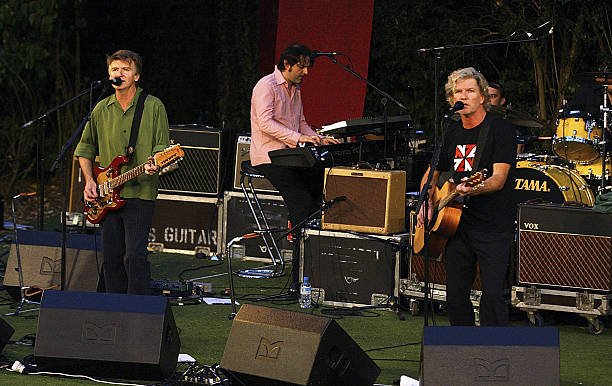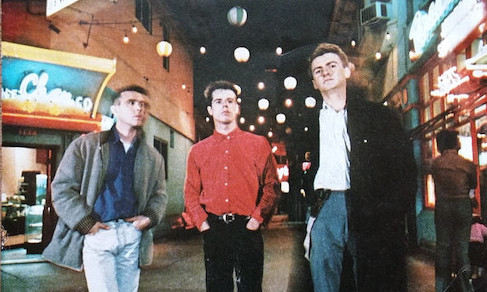Crowded House’s “Don’t Dream It’s Over” is one of the most enduring anthems of the 1980s. Unlike the bombastic power ballads typical of the era, its enigmatic lyrics and quiet dignity make the song timeless.
Crowded House formed from the ashes of Split Enz, the quirky New Zealand art-rock sextet founded by Tim Finn in 1972. Tim’s kid brother Neil joined the group in 1977 at age 19, replacing singer and guitarist Neil Judd. The younger Finn eventually began writing songs, penning “History Never Repeats,” “One Step Ahead” and the minor U.S. hit “I Got You” — contributions that moved the Enz in a more pop/new wave direction.

Tim Finn left Split Enz in 1984 to pursue a solo career, and instead of becoming the frontman of a band his brother formed, Neil decided to start from scratch with a new group and a stripped-down sound. He recruited drummer Paul Hester, who had joined Split Enz shortly before the group disbanded, and the two musicians set about recording demos to audition bass players. They found newcomer Nick Seymour (himself the younger brother of Mark Seymour, frontman of the Australian rock band Hunters & Collectors), whose soulful playing fit with Finn’s vision of a tight, guitar-based sound. The only other edict for the new lineup was that they all fit into one rental car, as Split Enz’s six-member roster had proved unwieldy on tour.

The newly minted trio initially called themselves the Mullanes (derived from the Finn siblings’ mother’s maiden name), but feared the moniker would be too easy to parody: they didn’t want journalists dubbing them “The Mundanes,” “The Dullanes,” “The Malaise,” etc. The group eschewed the traditional route of touring first and signing contracts later, opting instead to solicit labels in London and Los Angeles in search of a deal. In L.A. they met with Tom Whalley, a junior A&R man at Capitol Records, who asked them to keep in touch. After the meeting, the Mullanes decamped to Melbourne to gig and rehearse, all the while sending Whalley new songs. After a brief tour of eastern Australia to road-test their new sound, the Mullanes invited Whalley to Melbourne to see them perform. He finally committed to signing the group to Capitol, and proposed American Mitchell Froom as producer.
Although the name Crowded House was chosen as a nod to the cramped quarters Finn, Seymour and Hester shared while recording their eponymous first album, Froom’s uncluttered arrangements were crucial to the sound Finn was trying to achieve. “Everything had to have an organic nature to it for Mitchell to like it,” Finn told Australian magazine Beat shortly after the album’s release. “It was exactly what we wanted to do anyway. I wanted to make it sound like a band playing, which sounds like a simple thing, but it’s quite hard to achieve on record. It was a conscious attempt to keep things simple and, being the first album, we wanted to make a really honest start.”

Froom was relatively inexperienced behind the boards, but Finn was drawn to the live feel he’d achieved with Boston garage rockers the Del Fuegos. Froom, in turn, was attracted to Finn’s songwriting. Together they began work on “Don’t Dream It’s Over” in the producer’s home studio. Froom (who would go on to helm acclaimed records for Los Lobos, Suzanne Vega and Richard Thompson, as well as joining Los Lobos’ David Hidalgo and Louie Pérez in the Latin Playboys) suggested the melodic R&B bass line, and played the Hammond B3 organ solo that appears in the final mix. “These are influences I wouldn’t have come to myself, because they’re more American influences,” Finn told The Second Disc in 2016. “But I really enjoyed having a new angle, a new shading on the song.”
Though its message has been variously interpreted over the years as one of hope, strength and endurance (even pessimism: “Don’t dream. It’s over”), the song’s origins lie in a moment of personal isolation. Neil was at Tim’s house one afternoon for a social gathering, but the younger Finn wasn’t feeling particularly sociable. “So I disappeared into the music room and hopped on Tim’s piano and wrote ‘Don’t Dream It’s Over,’” he later told The Story Behind the Song podcast, adding “It was one of those songs that came largely in one go, which doesn’t happen very often. And is usually a good sign.” Writing the music and lyrics concurrently, Finn started with abstractions that fit the melody, choosing words for their sound as well as their meaning. “I don’t know that any of the lyrics were directly related to the fact that there were people in the house that I hadn’t wanted to socialize with, but in a sense, it was a private message from me to someone who was withdrawing from their world.”
“Don’t Dream It’s Over” became a guitar song as soon as Finn returned home. His demo, included on the 2016 deluxe release of Crowded House, uses a matchbox as a snare and a trash bin as a bass drum. The album cut is true to the home demo, although the addition of Froom’s organ (which recalls Procol Harum’s “A Whiter Shade of Pale”) and Seymour’s meandering bass give the recording a bluesy undercurrent.
Finn revealed to The Second Disc another reason for the song’s melancholic character: “Don’t Dream It’s Over” was the first Crowded House track recorded after session veterans Jim Keltner and Jerry Scheff replaced Hester and Seymour, respectively, to lay down a proper shuffle on the album’s second single, “Now We’re Getting Somewhere.” As a result, “there was a little bit of sadness when we cut ‘Don’t Dream It’s Over’ the next day,” Finn says. (Fun fact: Guitar shredder Joe Satriani is among the backing vocalists on the album cut.)
Capitol released Crowded House with little fanfare in July 1986. The label hoped the album would get an initial push from the band’s association with Split Enz, which still enjoyed a loyal following among fans and critics alike. Apart from that, however, Capitol seemed to have no strategy to hype the record. “They had a feeling there was no single, and were very confused about how to promote and market the band,” manager Gary Stamler recalls in the book Crowded House: Private Universe.

Capitol staunchly opposed introducing unknown acts via ballads, so execs chose the uptempo “World Where You Live” as Crowded House’s first international single. (“Mean to Me” was issued exclusively to the Australian market two months prior to the LP’s release.) Album-oriented radio failed to pick it up, so Capitol decided to follow this failure with “Now We’re Getting Somewhere” (another rocker), despite protests from Whalley and other Crowded House supporters at the label. “Everybody kept pointing to ‘Don’t Dream It’s Over,’” said Whalley. “We finally said ‘Instead of playing this game trying to figure out what uptempo song is the best one to lead with, let’s go with what we believe is a hit record.’”
Despite Capitol’s misgivings about its throwback sound (e.g., featuring Froom’s Hammond at a time when synthesizers ruled the airwaves), “Don’t Dream It’s Over” was finally released as a single on Aug. 27. The song was slow to take off. First, it had to compete with the looming Christmas season, when established artists typically release new material. Secondly, this was the year new rules determined how records were promoted and earned airplay. Prior to 1986, labels often employed third-party promoters to offer “promotion payments” to radio station directors for playing their client’s records. These promoters were independent — i.e., not technically affiliated with the label — which allowed them to get around the Federal Communications Commission’s regulations regarding payola, the practice of surreptitiously paying a commercial radio station to play a song to influence its perceived popularity.

Labels halted the “promotion payments” strategy after an NBC News investigation called “The New Payola” exposed the practice, leading to a round of Congressional investigations. Crowded House desperately needed a hit, however. “This was a radio promotion-based era,” Stamler said. “You either got a song on the radio and it sold, or you didn’t know what to do.” He finally hit upon an idea to hire a few out-of-work indies for a fraction of the exorbitant fees they previously charged. No one, save for the members of Crowded House and a lone Capitol executive, knew of Stamler’s plan: he even used pay phones when contacting promoters so no one could trace the calls back to the label.

Stamler’s derring-do paid off, and stations began playing “Don’t Dream It’s Over.” Capitol execs were none the wiser, crediting the single’s belated success to their own post-holiday promotional efforts. “I didn’t feel the need to rain on anyone’s parade,” said Stamler. “I felt it was better to let the label take pride, and think they were part of something that just happened organically.”
“Don’t Dream It’s Over” would prove to be Crowded House’s biggest hit, reaching a peak position of number two on the Billboard Hot 100 in April 1987 and number 13 on the trade publication’s year-end chart. In the decades since its release, the song has been covered by such disparate acts as Paul Young, Miley Cyrus, Sixpence None the Richer, Susan Boyle and Diana Krall, among others. “Don’t Dream It’s Over” was also used to great effect in the season six premiere of the FX network’s Cold War drama The Americans to reflect the widening chasm between the titular protagonists.

Finn recognizes the universality of “Don’t Dream It’s Over,” telling The Second Disc, “It’s an unconscious thing, but you try to create a feeling… the lyrics don’t spell it out in specific terms, so it allows people to see a lot of different angles in it.” Indeed, Finn could not have foreseen social media when he wrote the line “Try to catch the deluge in a paper cup,” nor our bifurcated political landscape captured in his words “They come to build a wall between us.” Had he set out to write an unambiguous “statement” song, however, we’d not likely be talking about “Don’t Dream It’s Over” decades later.
“The best songs, for me, are the ones that make you feel sad, but also make you feel that you’re sharing it with someone,” Finn reflects. “All I can really do is press the confusion that I’m usually in, so that other people can relate to it too.”

Don’t Dream It’s Over (KORD-0102)






